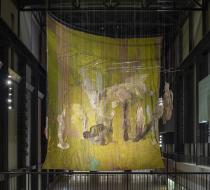The Aesthetic and Conceptual Impact of El Anatsui's Sculptures Favorite
El Anatsui, a visionary originally from Ghana, blends discarded materials into breathtaking sculptures that, in themselves, advocate for change and prompt us to reimagine our relationship with the environment.
His meticulous artistry serves as a vivid reminder of environmental challenges and promotes responsible consumption while honoring cultural diversity. Anatsui's installations go beyond galleries, they ignite contemplation and spark a dialogue on pressing social issues, inviting collective action. El Anatsui captures the essence of his causes. He inspires us to reassess our relationship with the environment. His narrative emboldens us to embrace cultural diversity, and become catalysts for a future where creativity, compassion, and activism seamlessly intertwine. (From Global Citizen)
El Anatsui (b. 1944 in Anyako, Ghana; lives and works in Nsukka, Nigeria and Tema, Ghana) transforms simple materials into complex assemblages that create a distinctive visual impact. His typical material palette includes discarded resources such as liquor bottle caps, printing plates and cassava graters to create sculptures that defy categorization. Anatsui’s choice of these materials reflects his interest in reuse, transformation and an intrinsic desire to connect to his native continent of Africa while transcending the limitations of place. His style combines the world history of abstract art with his local aesthetic traditions. Much of his work interrogates the legacy of colonialism, drawing connections between consumption, waste and the environment, but at the core is his unique formal language that distinguishes his practice.
Anatsui is particularly well-known for his large-scale sculptures composed of thousands of folded and crumpled pieces of metal sourced from local recycling stations and bound together with copper wire. His intricate works are both luminous and weighty, meticulously fabricated yet malleable. One of the conceptual underpinnings of much of the work is that the sculptures takes different forms each time they are installed. In morphing to activate various spaces, they challenge long-held views of sculpture as something rigid and insistent, which opens up his work to exist on its own terms. (From Jack Shainman Gallery)
For Example, El Anatsui’s Behind the Red Moon is a monumental sculptural installation made of thousands of metal bottle tops and fragments. Crumpling, crushing, and stitching them into different compositions, large panels are pieced together to form massive abstract fields of colour, shape and line. The commission builds on Anatsui’s interest in histories of encounter and the migration of goods and people during the transatlantic slave trade. Sourced in Nigeria, the liquor bottle tops used in this commission form part of a present-day industry built on colonial trade routes.
Behind the Red Moon is staged as an artwork in three acts. Visitors are invited to embark on a journey of movement and interaction through the hangings, a dance between bodies and sculptures.
Viewing the hangings from afar, a landscape of symbols is revealed: the moon, the sail, the wave, the earth, and the wall. Up close, the bottle tops’ logos speak to the material’s social lives as commodities of a global industry built on colonial trade routes. Together, the past and present of Africa and Europe merge into sculptural forms that hang in the air and appear to float across the space. The hangings embody Anatsui’s idea of the ‘non-fixed form’, and are part of his highly experimental approach to sculpture.
Anatsui engages with the poetic possibilities of his materials. ‘Each material has its properties, physical and even spiritual,’ he explains. Behind the Red Moon explores elemental forces interwoven with human histories of power, oppression, dispersion and survival. (From Tate)







